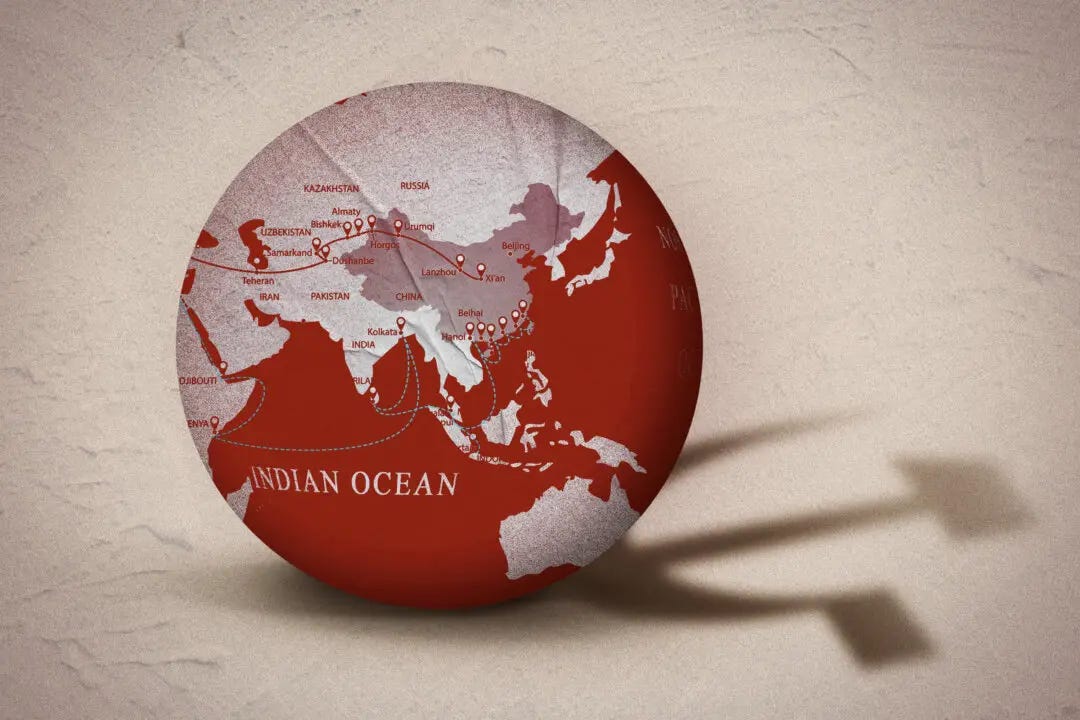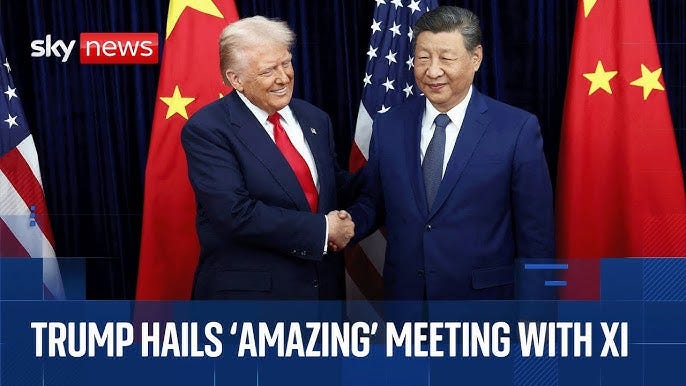Trump's Asian Triumph and the Collapse of China’s Grand Strategy
The President's one-year trade truce with China got most of the attention. But deals with Japan and South Korea help illustrate the enormous reversal the CCP has suffered under Xi Jinping.
NOTE: Before we begin, a recap of what President Trump accomplished on his Asian tour.
The President signed supply deals for Rare Earth Elements with Cambodia, Japan, Malaysia, Thailand, South Korea, and Vietnam. This is not just mining: the deals with Thailand, Malaysia, and Japan include the creation of significant refining capacity, 92% of which is currently in China. The Japan deal also includes a crash deep-sea mining initiative, with significant long-term implications. All of this complements Trump’s initiatives at home, plus his deal 10 days ago with Australia to develop mining and refining there also.
China badly overplayed its hand. It will now lose its monopoly as surely as night follows day, depriving it of perhaps its greatest advantage. Global security will be greatly enhanced.Trump left Tokyo with a much-strengthened alliance both with Japan and its new Prime Minister Sanae Takaichi, “the Margaret Thatcher of Asia”. But he also accelerated $550 billion of new Japanese investment into the United States, part of nearly $3 trillion in commitments on this trip alone. Of particular note are Japan’s large-scale investment in U.S. shipbuilding and purchases of energy, heavy equipment, and food.
In South Korea, Trump greatly extended his recently reaffirmed AUKUS deal by approving Korea’s purchase of nuclear attack submarines, to be built in Philadelphia. Australia and South Korea are the only countries to which the United States has ever sold nuclear submarines, and both deals will require vast expansions of American shipbuilding capacity (and jobs). South Korea will invest a total of $350 billion in the U.S., including $150 million for the Philadelphia shipyard, plus vast purchases of U.S. oil and LNG, in exchange for tariff reductions (oh, and the nuclear submarines, which they’ll still have to purchase).
Trump presided over the formalization of the Thailand-Cambodia peace deal he negotiated, and inked trade deals with Vietnam, Cambodia, Thailand, and Malaysia.
Finally, the President met with Xi Jinping, inking more or less the trade deal we’ve been telling you would happen. It’s a one-year truce, during which Trump’s threatened 100% tariff will not be imposed, and China’s threatened restrictions on Rare Earth Elements exports will be withdrawn. China will buy “tremendous amounts” of U.S. soybeans and other farm goods, and will crack down on the export of fentanyl precursors.
On the table for further negotiation: expanded U.S. technology exports (including AI chips), and large-scale Chinese purchases of U.S. oil and LNG, possibly replacing Russian supply. Aside from sinking the Russian economy, this would make a Chinese war with the United States virtually unthinkable. Stay tuned.
But the most telling point is the “reduced” tariffs. China will now charge the U.S. 10%; the U.S. will charge China a whopping 47%, actually down in exchange for Chinese action on fentanyl.
The fact that China agreed to this sets up quite perfectly our main essay, below. Many in the Western press want you to think, due to their TDS, or perhaps their having flunked first-grade math, that China somehow “won” this negotiation. But 10% vs. 47% is not winning, not by a long shot.
So why’d they agree? Simple: Xi Jinping’s Belt and Road Initiative and aggressive posture have been catastrophic failures. China’s grand strategy is collapsing. And understanding the cracks in their system, Trump pressed the advantage home.
China is still a significant adversary. There is still a lot to do, and a lot to guard against. But after the events of this week — beginning with Xi’s apparent loss of control over the military, and ending with this “truce” with Trump — they’re a lot less significant than was widely believed just a few short months ago (though not believed if you listened to us). And that leaves China one good card, and many bad ones, to play. — RDM
The Collapse of China’s Grand Strategy
by Frank Tian Xie and Talai Osmonbekov
October 31, 2025
For over a decade, China pursued an ambitious grand strategy aimed at displacing U.S. leadership and reshaping the global order in its authoritarian image.
Under Xi Jinping, Beijing expanded its economic, technological, military, and political footprint — from the Belt and Road Initiative (BRI) to military outposts in the South China Sea — while allying with rogue regimes like those in Russia and Iran to stretch U.S. power thin.
Yet, that strategy is now collapsing. The BRI is mired in debt and dysfunction, China’s tech ambitions are stymied by export controls, and its authoritarian allies are unraveling under geopolitical and military pressure. Internally, Xi faces growing dissent and instability within the Chinese Communist Party (CCP) itself.
Facing stagnation and decline, isolation, and a fraying coalition, Beijing needs a grand bargain with Washington — not as triumph, but as retreat. This would mark an opening for the United States to press for systemic concessions: ending support for adversarial regimes, halting maritime militarization, and rebalancing trade.






